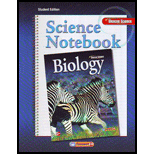
To fill:
The correct words in the blanks to complete the given paragraph.
Introduction:
Matter is anything that has mass and occupies space. It is made of tiny particles called atoms. Atoms are made of still smaller particles called protons, electrons and neutrons. Neutrons and protons are located in nucleus in the center of an atom. Electrons revolve around the nucleus in different energy levels or orbits.
Answer to Problem 4MI
| S. No. | Term |
| 1 | Element |
| 2 | Isotope |
| 3 | Compound |
| 4 | Covalent bond |
| 5 | Molecule |
| 6 | Ion |
| 7 | Ionic bond |
| 8 | Van der Waals force |
Explanation of Solution
An element is a pure substance that cannot be broken down into other substances by any physical or chemical means. Elements are made of only one type of atom.
Atoms of an element have same number of protons and electrons but some atoms may have different number of neutrons. Such atoms are called isotopes. The most abundant form of carbon, carbon- 12, has six protons and six neutrons in its nucleus. An isotope of carbon, carbon- 14 has six protons and eight neutrons. Isotopes have same chemical properties.
Elements can combine to form more complex substances. A compound is a pure substance formed when two or more different elements combine. Compounds have unique physical and chemical characteristics different from the characteristics of elements that comprise them.
Compounds are formed when two or more substances combine. The force that holds these substances together is called a
A molecule is a compound in which atoms are held together by covalent bonds. Covalent bonds can be single, double or triple depending on the number of pairs of electrons shared.
Atoms are neutral; that is they do not have any electrical charge. For an atom to be stable, the outermost energy level must be either empty or completely filled. Some atoms tend to gain or lose electrons in order to empty or fill the outer energy level to become stable.
An atom that has lost or gained one or more electrons becomes an ion and carries electric charge. For example, sodium has one electron in its outermost shell. It can become stable by losingone electron leaving its outermost energy level empty. When it gives away one negative charge, the neutral sodium atom becomes a positively charged sodium ion (Na+).
The movement of electrons in a molecule causes an unequal distribution of an electron cloud around a molecule. This creates temporary areas of positive and negative charges. Attractive forces between these positive and negative charges hold the molecules together. This force is called Van der Waals force of attraction. It is very important for biological processes.
Chapter 6 Solutions
Biology Science Notebook
Additional Science Textbook Solutions
Campbell Biology: Concepts & Connections (9th Edition)
Campbell Biology in Focus (2nd Edition)
Microbiology with Diseases by Taxonomy (5th Edition)
Human Anatomy & Physiology (2nd Edition)
Biology: Life on Earth (11th Edition)
Human Anatomy & Physiology
 Human Anatomy & Physiology (11th Edition)BiologyISBN:9780134580999Author:Elaine N. Marieb, Katja N. HoehnPublisher:PEARSON
Human Anatomy & Physiology (11th Edition)BiologyISBN:9780134580999Author:Elaine N. Marieb, Katja N. HoehnPublisher:PEARSON Biology 2eBiologyISBN:9781947172517Author:Matthew Douglas, Jung Choi, Mary Ann ClarkPublisher:OpenStax
Biology 2eBiologyISBN:9781947172517Author:Matthew Douglas, Jung Choi, Mary Ann ClarkPublisher:OpenStax Anatomy & PhysiologyBiologyISBN:9781259398629Author:McKinley, Michael P., O'loughlin, Valerie Dean, Bidle, Theresa StouterPublisher:Mcgraw Hill Education,
Anatomy & PhysiologyBiologyISBN:9781259398629Author:McKinley, Michael P., O'loughlin, Valerie Dean, Bidle, Theresa StouterPublisher:Mcgraw Hill Education, Molecular Biology of the Cell (Sixth Edition)BiologyISBN:9780815344322Author:Bruce Alberts, Alexander D. Johnson, Julian Lewis, David Morgan, Martin Raff, Keith Roberts, Peter WalterPublisher:W. W. Norton & Company
Molecular Biology of the Cell (Sixth Edition)BiologyISBN:9780815344322Author:Bruce Alberts, Alexander D. Johnson, Julian Lewis, David Morgan, Martin Raff, Keith Roberts, Peter WalterPublisher:W. W. Norton & Company Laboratory Manual For Human Anatomy & PhysiologyBiologyISBN:9781260159363Author:Martin, Terry R., Prentice-craver, CynthiaPublisher:McGraw-Hill Publishing Co.
Laboratory Manual For Human Anatomy & PhysiologyBiologyISBN:9781260159363Author:Martin, Terry R., Prentice-craver, CynthiaPublisher:McGraw-Hill Publishing Co. Inquiry Into Life (16th Edition)BiologyISBN:9781260231700Author:Sylvia S. Mader, Michael WindelspechtPublisher:McGraw Hill Education
Inquiry Into Life (16th Edition)BiologyISBN:9781260231700Author:Sylvia S. Mader, Michael WindelspechtPublisher:McGraw Hill Education





